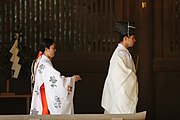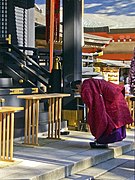Kannushi
You can helpexpand this article with text translated fromthe corresponding articlein Japanese.(January 2024)Click [show] for important translation instructions.
|
| Part ofa serieson |
| Shinto |
|---|
 |
Akannushi(Thần chủ,"divinemaster (of ceremonies)",originally pronouncedkamunushi),also calledshinshoku(Thần chức,meaning "employee/worker of kami" ),is a person responsible for the maintenance of aShintoshrine(Thần xã,jinja)as well as for leading worship of a givenkami.[1]The characters forkannushiare sometimes also read asjinshuwith the same meaning.
History
[edit]Originally, thekannushiwere intermediaries betweenkamiand people and could transmit their will to common humans.[2]Akannushiwas a man capable of miracles or a holy man who, because of his practice ofpurificatory rites,was able to work as a medium for akami.Later the term evolved to being synonymous withshinshoku- a man who works at a shrine and holds religious ceremonies there.[1][3]
In ancient times, because of the overlap of political and religious power within a clan, it was the head of the clan who led the clansmen during religious functions, or else it could be another official.[3]Later, the role evolved into a separate and more specialized form. The term appears in both theKojiki(680 AD) andNihon Shoki(720 AD),[3]where theEmpress JingūandEmperor Sujinrespectively becomekannushi.[2]
Description
[edit]Within the same shrine, such as atIse JingūorŌmiwa Shrine,there can be different types ofkannushiat the same time; these may be called, for example,Ō-kannushi(Đại thần chủ),Sō-kannushi(Tổng thần chủ),orGon-kannushi(権 thần chủ).[2][3]Kannushiare assisted in their religious or clerical work by women calledmiko.
Kannushican marry, and their children usually inherit their position.[4]Although this hereditary status is no longer legally granted, it continues in practice.[5]
Vestments and ritual objects
[edit]The clotheskannushiwear, such as thejōe,theeboshiandkariginu,do not have any special religious significance, but are simply official garments previously used by the Imperial court.[4]This detail reveals the close connection betweenkamiworship and the figure of the Emperor.[4]Other implements used bykannushiinclude a baton calledshakuand a wand decorated with white paper streamers (shide) calledōnusa.
-
Akannushiin full dress,Katori Shrine
-
Akannushiwearing akariginuand aneboshihat
Education
[edit]To become akannushi,anovicemust study at a university approved by theAssociation of Shinto Shrines(Thần xã bổn sảnh,Jinja Honchō),typicallyTokyo'sKokugakuin UniversityorIse'sKogakkan University,or pass an exam that will certify his qualification.[5]Womencan also becomekannushi,and widows can succeed their husbands in their job.[5]
Onshi
[edit]An Onshi or Oshi ( ngự sư ) is a lower level Shinto priest analogous to adeaconor anacolyte.They are considered between a layperson and clergy.
See also
[edit]References
[edit]- ^ab*Kannushi(in Japanese), IwanamiKōjien(Quảng từ uyển)Japanese dictionary, 6th Edition (2008), DVD version
- ^abc Nishimuta, Takao (2007-03-28)."Kannushi".Encyclopedia of Shinto.Kokugakuin.Retrieved2009-10-16.
- ^abcd Moriyasu, Jin."Kannushi".Nihon Hyakka Zensho(in Japanese). Shogakukan. Archived fromthe originalon 2012-12-09.Retrieved2009-10-16.
- ^abc Nishimura, Hajime (1998).A Comparative History of Ideas.Motilal Banarsidass.ISBN978-81-208-1004-4.
- ^abc "Shinshoku".Encyclopædia Britannica Online.Retrieved2009-10-16.
External links
[edit]- Kannushi,Encyclopedia of Shinto



